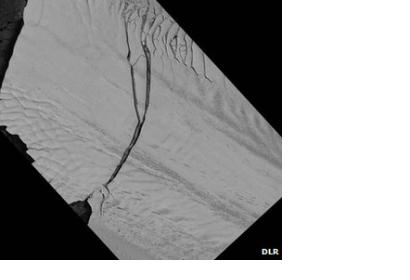The DLR-operated TerraSAR-X Earth observation satellite has documented the gradual propagation of the first crack in the Pine Island Glacier (PIG) over a period of several months. PIG is the longest and fastest flowing glacier in the western Antarctic, flowing from the Hudson Mountains into the Amundsen Sea. The satellite data confirmed the crack's expansion to full width and the spawning of a new iceberg of the size of Hamburg, as a result of the fracture, as BBC news reported.
TerraSAR-X is in a near-polar orbit around the Earth, at an altitude of 514 kilometres. It carries a radar instrument that can detect the surface of the ice stream even in darkness. Using its active radar antenna, it is able to produce image data with a resolution of down to one metre, regardless of weather conditions, cloud cover or absence of daylight.
Dana Floricioiu, from the DLR Remote Sensing Technology Institute, has been monitoring this crack on the Pine Island Glacier since the very beginning, and has derived valuable data such as the velocity field of the glacier. "Above this crack, the glacier was most recently flowing at a rate of 12 metres per day," reports Floricioiu. "The second crack was discovered in May, and this gave rise to an additional, 30-square-kilometre iceberg that has moved into the polar ocean along with its 'big brother'," continues Humbert.
BBCnews specifies: "By now, Satellite and airborne measurements have recorded a marked thinning and a surge in velocity of the PIG in recent decades. This has been attributed in part to warmer waters resulting from the general global warming. This causes the rapid shrinking of the PIG which, as it losses ice, "It contributes to sea level rise faster than any other glacier on the planet" explains Prof David Vaughan from the British Antarctic Survey (BAS), "That makes it worthy of study"."

